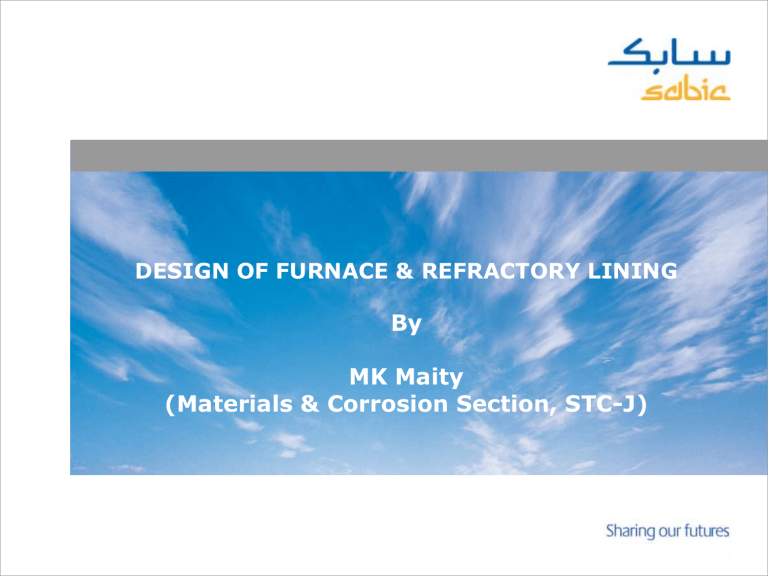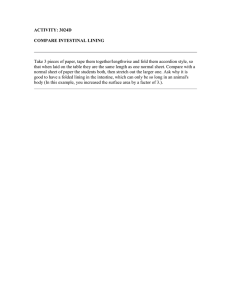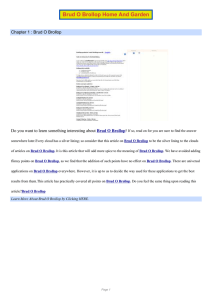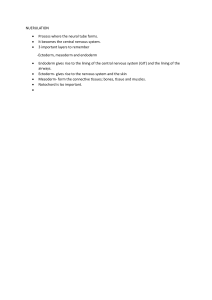
DESIGN OF FURNACE & REFRACTORY LINING By MK Maity (Materials & Corrosion Section, STC-J) v THE PERFORMANCE OF REFRACTORY LINING DEPENDS ON Lining Design Selection of Material Installation Operation Of Furnace Maintenance 2 OBJECTIVE OF A GOOD LINING DESIGN Operation & Production At Optimum Cost & Expenses Of Refractories Used To Obtain Optimum Trouble Free Service Life To Have Reliable & Dependable Lining System Ease Of Material Procurement Ease Of Installation Future Ease Of Maintenance Ease Of Repair 3 DESIGN & DETAIL ENGINEERING Detail Of Lining : • Materials Quality • Thickness • Heat Transfer Calculations • Shape & Size Of Bricks , C.F.Modules, Etc. • Dimensional Tolerances, • Laying Pattern • Lining Details Of Openings, Corners, Junctions • Type Of Mortar & Mortar Joint • Type Of Expansion Joint, Location & Width 4 DESIGN & DETAIL ENGINEERING Detail Of Lining : Anchor & Hard-wares: • Anchor & Support Quality • Anchor Design , Dimension, Height • Anchor Spacing & Orientation • Vapor Barrier ( SS, Al foil) • Corrosion Resistant Coating 5 DESIGN & DETAIL ENGINEERING Refractory Materials: • • • Material Specifications & Test Methods Quantity of Materials & Overages Suppliers Installation: • • • • • • 6 Installation Method Sequence of Installation Selection of Contractors Lining Dry Out Inspection Test Plan & Acceptance Criteria Special Requirements LINING SYSTEM 1. Brick Lining • Different Shapes • Insulating & Dense Type • Type of Mortar 2. Monolithic / Concrete Lining 3. Ceramic Fibre Lining( Blanket & Module) 4. Combination 7 FACTORS FOR LINING DESIGN & SELECTION OF MATERIALS 1. Operating Temperature 2. Mode Of Operation (Intermittent/ Cyclic, Continuous) 3. Furnace Atmosphere (Oxidizing, Reducing, Neutral) 4. Furnace Pressure ( +Ve, -Ve, Neutral) 5. Geometry Of Furnace 6. Type Of Furnace (Static, Rotating, Tilting) 7. Interface Temperature Between The Layers , Temp Gradient 8. Expected Casing Temperature And Heat Loss 8 MAJOR FACTORS CONSIDERED FOR LINING DESIGN 9. 10. 11. Requirement Of Furnace Efficiency Physical Abuses Such As Abrasion, Erosion Etc. Thermo-chemical Attack : Corrosion 12. Function Of Furnace: Heating Of Solid, Melting, Heating Of Gases, Hydrocarbons, Etc. 13. Gas Composition Within The Furnace (Sulfur, Sodium, Potassium, Chlorine, Hydrogen Etc.) 14. Expected Life Of Furnace 15. Cost And Economics 16. Ease Of Installation, 17. Future Ease Of Maintenance & Repair 9 SELECTION OF REFRACTORIES Chemical Composition Apparent Porosity Bulk Density Co-efficient Of Thermal Expansion Permanent Linear Change Refractoriness Under Load Pyrometric Cone Equivalent 10 SELECTION OF REFRACTORIES Thermal Conductivity Spalling Resistance Performance Under Various Gaseous Atmosphere Permeability Mechanical Strength (Room Temperature & High Temperature) Abrasion / Erosion Resistance Resistance To Chemical Attack 11 HEAT FLOW CALCULATION INPUT: Operating Temperature Ambient Temperature Operating Pressure External Wind Velocity Thermal Conductivity Emissivity Heat Flow Direction Inside Gas Composition (Hydrogen, Etc.) 12 OUTPUT: External Shell Temperature Interface Temperature Heat Loss From Surface THERMAL / HEAT FLOW CALCULATION HOT Layer 1: IFB, Gr. 28 Layer 2: IFB, Gr. 23 Layer 3: Fibre Block 1100°C Layer 4: Fibre Block 800°C Layer 1: MW Concrete Layer 2: CRF Board 1260°C Layer 3: Fibre Block 1000°C Layer 4: Fibre Block 800°C Layer 1: CRF Modules 1430°C, 192kg/m³ Layer 2: CRF Blanket 1260°C Layer 1: CRF Blankets 1430°C, 160kg/³ Layer 2: CRF Blanket 1260°C Heat Flow Calculation for: tAMB=27°C, tINS=1200°C, wind=0m/s, ε=0.95 tOUTS=72°C qloss=576 W/m² tOUTS=78°C qloss=676 W/m² Water Content≈92kg/m² 13 tOUTS=73°C qloss=601 W/m² tOUTS=69°C qloss=528 W/m² LINING THICKNESS Factors Determining Thickness : Operating Temperature Corrosion, Erosion Etc. Thermal Calculation Design Casing Temperature Strength Installation Method Service Life 14 LINING STRUCTURE AND SELECTION OF MATERIALS SINGLE LAYER: Low Operating Temperature Less Severe Conditions MULTI LAYER: High Operating Temperature, Low Heat Loss Requirement Severe Conditions COMBINED: Combination Of Brick, Block, castable, Ceramic Fibre Material 15 LINING FOR MOLTEN STEEL / SLAG Linings Consist Of A Safety Lining And A Working Lining • Safety Lining Is Usually Provides Security Insulation For The Vessel & • Working Lining Is In Direct Contact With Steel And Slag. • Zone Wise Different Refractory To Match The Conditions It Is Exposed To Have Balanced Deterioration 16 REFRACTORY WEAR MECHANISMS IN STEEL PLANT – Corrosion • Chemical Reactions Between Slag Components (FeO, MnO and SiO2) & Refractory • Refractory Is Soluble In Steelmaking Slag • Corrosion Can Be Minimized By Saturating Slag (With MgO From Dololime & Controlling Over Oxidation ) – Oxidation • Oxidation Occurs When Carbon In Refractory Reacts With Oxygen From Slag (FeO) Or The Atmosphere And Burns • As The Carbon Is Oxidized The Refractory Loses Its Strength – Erosion • When Liquid Steel Or Slag Flows Over A Refractory Surface & Abrades Surface 17 HEIGHT OF LINING Brick-wall Mostly Self Supporting Type & Height Is Determined On Basis Of : Stability Of Wall Load At Bottom Vertical Expansion Etc. Monolithic Lining No Restriction In Height, As Weight Of Refractory Is Uniformly Distributed Amongst The Anchors 18 THERMAL EXPANSION OF LINING • Expansion Joints In Brick Lining Are Necessary In Order To Protect The Lining And Shell Against Forces Due To Thermal Expansion Of Brick. • Expansion Joints In Monolithic Lining Often Not Necessary Since Anchor Fitted To The Furnace Shell Allow Limited Movement Due To Thermal Expansion. • Expansion Joints Are Necessary In Monolithic Lining That Are Not Supported By Anchor • Size Of Expansion Joint Depends On Drying + Heating Shrinkage, Expansion Of Material , Shell / Casing Etc. 19 SHRINKAGE OF LINING : Monolithic Refractory Lining Usually Shrinks During Post Installation Drying And When Cooled After Heating. To Protect The Lining From Damage Due To Shrinkage, Joints Are Left At Appropriate Intervals So That These May Take Up The Shrinkage. 20 ANCHORS FOR REFRACTORY LINING Function Of Anchor: To Hold Refractory in Position Provide Support For Wall & Arches & Flat Roof Prevent Bulging & Bowing Of Lining Allow Horizontal & Vertical Movement Of Lining 21 TYPES OF ANCHOR • Metallic Anchors • Ceramic Anchors Metal Anchor L Type V Type Y Type Hexmesh Chain Link Wire Mesh Anchor For Ceramic Fibre Lining Special Anchor 22 DESIGN OF ANCHOR SYSTEM Anchor Quality Diameter Of Anchor Rod Anchor Configuration Anchor Spacing Anchor Orientation Anchor Height / Cover Plastic Cap / Coating On Anchor 23 SELECTION CRITERIA OF ANCHOR SYSTEM Type Of Lining & Lining Thickness Type Of Refractory Materials Furnace Operating Conditions Position Of Lining ( Vertical, Horizontal, Inclined, Floor, Circular Etc.) Mechanical Movement Etc. 24 CERAMIC ANCHOR 25 STEEL FIBRE REINFORCEMENT IN REFRACTORY CASTABLE ADVANTAGES: • Higher Tensile, Flexural And Compressive Strength • Improved Resistance To Damage From Vibration, Impact And Thermal Shock • Better Resistance To Cracking • Better Performance Under Abrasive Conditions 26 TYPE OF STEEL FIBRES & THEIR CHARACTERISTICS : • Type Of Fibre : Steel Wires, Thin Steel Wares, Melt Extraction, Shaving Thick Steel Plates • Dia. Of Fibre (D) : 0.3 Mm To 0.5 Mm • Length (L) : 25 Mm To 30 Mm • Aspect Ratio (L/D) : 50 To 100 • Material Quality : SS 304, SS 410, SS 310 Etc. 27 SULFURIC ACID CONDENSATION Flue gas constituents: • • • • H2O (Steam), SO2 & SO3 (Gases) CO, CO2 , N2 , NOx , Cl, (Gases) H2SO4 , HCl, HNO3 (Gases) Compounds of Na, V, Ash Etc. (Depending of type of fuel, furnace charge, etc.) S + O2 SO2 (Gas) ( Conversion ~ 1-5 %) SO2 + O2 SO3 (Gas) + H2O (Steam) SO3 (Gas) H2 SO4 (Gas) Temp< Dew Point 120-160 0C 28 H2 SO4 (Liquid) PHYSICAL BARRIER INSIDE LINING • Metallic Foil / Sheet ( SS, Al) Between Refractory Layers • Thickness 0.1 to 0.15mm SS Sheet Mainly For Cold Wall Design Furnaces: • • Casing Temperature Is Maintained Approx. 60 to 100 0C. Very High Thermal Efficiency Is Expected Heater, Primary Reformer, Cracker TYPICAL SS SHEET BARRIER SS Foil Over Insulating Board 30 THANK YOU



